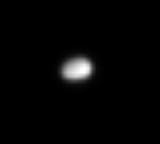Polydeuces (moon)
| Polydeuces | |
|---|---|

|
|
| Polydeuces captured by the Cassini spacecraft | |
| Provisional or systematic name | S / 2004 S 5 |
| Central body | Saturn |
| Properties of the orbit | |
| Major semi-axis | 377,400 km |
| Periapsis | unknown |
| Apoapsis | unknown |
| eccentricity | 0.0192 |
| Orbit inclination | 0.18 ° |
| Orbital time | 2.737 d |
| Mean orbital velocity | 10.0 km / s |
| Physical Properties | |
| Apparent brightness | 25 likes |
| Medium diameter | ≈ 2.6 km |
| Dimensions | ≈ 4.4960 × 10 12 kg |
| surface | 21.24 km 2 |
| Medium density | 0.5 g / cm 3 |
| Sidereal rotation | 2.737 d |
| Acceleration of gravity on the surface | 0.00018 m / s 2 |
| Escape speed | ≈ 0.6 m / s |
| discovery | |
| Explorer |
Carolyn Porco , Cassini Imaging Science Team |
| Date of discovery | October 21, 2004 |
Polydeuces (also Saturn XXXIV) is one of the smaller moons of the planet Saturn . It is a Trojan moon that moves in the same orbit as the larger moon Dione .
discovery
The discovery of Polydeuces on images taken by the Cassini spacecraft on October 21, 2004 was announced on November 8, 2004 by Carolyn Porco and the Cassini Imaging Science Team. Polydeuces was initially given the provisional designation S / 2004 S 5. In January 2005 the moon was then named after Polydeuces .
Orbit data
Polydeuces orbits Saturn at a mean distance of about 377,200 km in 2.737 days. It is one of two small moons on the same orbit as the large moon Dione. Polydeuces follows Dione at an angular distance of 60 ° in the following Lagrangian point L 5 . In the leading Lagrangian point L 4 , the moon Helene Dione runs ahead at an angle of 60 °.
Structure and physical data
Polydeuces has an irregular shape with axis lengths of 3.0 × 2.4 × 2.0 km.
Web links
- Polydeuces: By the Numbers. At: solarsystem.nasa.gov
- IAUC 8432: Satellites and Rings of Saturn November 8, 2004 (discovery)
- IAUC 8471: Satellites of Saturn January 21, 2005 (numbering and naming)
Individual evidence
- ^ Saturnian Satellite Fact Sheet. At: nssdc.gsfc.nasa.gov (Last update: October 13, 2015)
| further inside | Saturn moons | further outside |
| Helene |
Semi- major axis (km) Polydeuces 377.400 |
Rhea |